 |
Contact usUnited Caribbean TrustReconstructionThe Building SystemDevelopments
UCT Guyana visit |
home >> united caribbean
trust UNITED CARIBBEAN TRUST - Building System design  The
Building System allows for the incorporation of many customized ideas into
the finished building plans. Floor plans can be designed to suit almost
any requirements that can be satisfied with conventional construction. The
Building System allows for the incorporation of many customized ideas into
the finished building plans. Floor plans can be designed to suit almost
any requirements that can be satisfied with conventional construction. 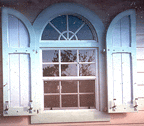 Even
though there are available, hundreds of finished floor plans for buildings
completed in over 25 nations worldwide, the homeowner, builder and architectural
designer are encouraged to create their own floor plan to suit their needs
and budget. A full time architectural design staff, using the latest in
computer aided design programs, is available to work from existing sketches
or architectural plans. Quotations can be developed which include the cost
of building components, engineering drawings, packaging and shipping, in
less than seven days. Even
though there are available, hundreds of finished floor plans for buildings
completed in over 25 nations worldwide, the homeowner, builder and architectural
designer are encouraged to create their own floor plan to suit their needs
and budget. A full time architectural design staff, using the latest in
computer aided design programs, is available to work from existing sketches
or architectural plans. Quotations can be developed which include the cost
of building components, engineering drawings, packaging and shipping, in
less than seven days.
A variety of: Component packages can be ordered without certain standard components such as windows, doors and ceiling treatment if these may be supplied locally. Window and door panels will be supplied with standard sized pre-framed openings that have steel jambs, headers and sills. Conventional wood and masonry construction can be used in conjunction with the System as long as all wall panels and roof members are secured to the steel components or locally supplied steel reinforced concrete. Wood floors or columns are not acceptable for structural components, but a wood deck, arbor or trim piece can be attached to or used in conjunction with the Building System.
Depending on the hurricane and earthquake requirements, most interior wall panels are utilized for bracing strength to achieve the engineering requirements for hurricane and earthquake loads. Steel portal beams can be used for large open rooms to satisfy the minimum bracing requirements in place of interior or exterior wall panels. Once the minimum requirements are satisfied, all other interior walls can be attached to the floor and roof trusses off-grid, if necessary. Custom wall panels can be manufactured at an additional cost. Odd sized wall lengths can be fabricated on site with factory or locally supplied materials. Conventionally constructed walls composed of masonry, stone, brick or wood can be attached to the wall system to suit the customers needs. |

 

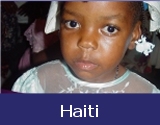 |
|
Hebel Block lightweight concrete architectural features
are used to simulate quoins on the corners of this house. 1) "Sierra" fiber-cement board is painted locally
for a modern wood house appearance that has a vertical wood texture. The
vertical panel joints are weather-sealed with a P.V.C. joiner strip that
has the same finished appearance as the joints between the vertical- plank
pattern of the fiber-cement board. When this completed wall surface is
painted the panel joints disappear. This is the least costly finish available.
When completed, the exterior of the house is indistinguishable from a traditional wood home. The fiber-cement planks are an excellent improvement over their wood counterparts because they are water, termite, fire and rot resistant. They won't shrink, warp or crack and therefore hold paint better than wood planks. Many other exterior and interior wall finishes can be achieved easily such as brick or stone entries, ceramic tiled showers, wall-papered rooms or even marble walled bathrooms. The fiber-cement board on all the wall panel surfaces can be treated like a smooth masonry surface when considering the attachment of any finishes.
Three distinctly different and attractive roof sheeting profiles that come with factory applied paint coatings and are guaranteed for 20 years: - BHP "Zincalume" Colorbond Steel in a six rib trapezoid profile and four color choices - Colorcote "Zincalume" Custom Orb in a standard "galvanized" profile and 40 color choices - Besalon "Zincalume" in a tile-like profile and 40 color choices There are many attractive colors to chose from and all the roof accessories such as the gable and hip ridge caps, gable end caps, screws and washers are color matched to the sheeting color.
To add another dimension to the ceiling treatment, the following materials are used: - Non-structural rafters and beams can be attached to the ceiling after the sheathing is applied. - Tray or hip ceilings can be created with support members attached to the wall panels and the bottom chord of the trusses. The sheathing is then applied to these custom ceiling support members. Internal soffits, drop ceilings and valences can also be created with this method.
|
| Copyright © 2022 www.UnitedCaribbean.com. All rights reserved. Disclaimer Click to Contact us |
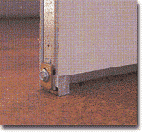 All
floor plans are based on a one-meter grid. Exterior wall panels are centered
on the one-meter grid lines and all roof trusses attach at the juncture
of the wall panels. A special 45-degree wall panel that runs from corner
to corner of a one meter grid box can also be incorporated.
All
floor plans are based on a one-meter grid. Exterior wall panels are centered
on the one-meter grid lines and all roof trusses attach at the juncture
of the wall panels. A special 45-degree wall panel that runs from corner
to corner of a one meter grid box can also be incorporated.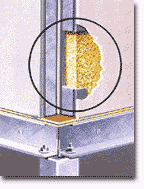 The
wall panels are clad with a high quality fiber-cement board, manufactured
by James Hardie, Inc., that can be finished with paint, plaster, acrylic
texture finish, ceramic tile, brick, real or cultured stone or wallpaper.
The
wall panels are clad with a high quality fiber-cement board, manufactured
by James Hardie, Inc., that can be finished with paint, plaster, acrylic
texture finish, ceramic tile, brick, real or cultured stone or wallpaper.
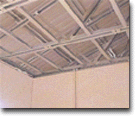 There
are many attractive roof designs that can be utilized on all these buildings
such as: - Gable, Half Gable, Hip, Dutch Hip, Polynesian Style and Veranda
Shed Roofs A wide variety of architectural styles can be achieved by combining
hip, gable and shed roofs on one and two story designs to suit the local
architectural aesthetic.
There
are many attractive roof designs that can be utilized on all these buildings
such as: - Gable, Half Gable, Hip, Dutch Hip, Polynesian Style and Veranda
Shed Roofs A wide variety of architectural styles can be achieved by combining
hip, gable and shed roofs on one and two story designs to suit the local
architectural aesthetic. 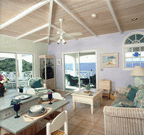 The
galvanized steel roof trusses can be ordered with either flat bottom chords
or with cathedral bottom chords, which have a slope of approximately five
degrees, rising from the exterior walls to the center of the truss. The
standard materials supplied for sheathing the underside of the bottom
chord is a 10mm long span gypsum board with screws, paper tape and gypsum
compound for finishing the screw holes and joints. There are many other
choices of ceiling sheathing that can be utilized to achieve different
effects such as: - Fiber-cement board with a stucco or "popcorn"
finish. - Wood planks or tongue and groove boards that can be painted,
stained or pickled.
The
galvanized steel roof trusses can be ordered with either flat bottom chords
or with cathedral bottom chords, which have a slope of approximately five
degrees, rising from the exterior walls to the center of the truss. The
standard materials supplied for sheathing the underside of the bottom
chord is a 10mm long span gypsum board with screws, paper tape and gypsum
compound for finishing the screw holes and joints. There are many other
choices of ceiling sheathing that can be utilized to achieve different
effects such as: - Fiber-cement board with a stucco or "popcorn"
finish. - Wood planks or tongue and groove boards that can be painted,
stained or pickled.  Many
local architectural styles can be achieved by embellishing this Building
System with accessories and attachments that can be locally supplied or
included in the component package. Several projects have employed a variety
of custom wood accessories attached to their windows, verandas and roof
gable ends to add a special architectural flair that creates an aesthetically
pleasing look that is consistent with local architectural styles. We have
also employed locally supplied stone walls, arched beams, elliptical windows,
wood shutters, plastic lattice, fiber-cement and polyester columns to
add flair to many projects. The possibilities are endless and are only
limited by the imagination. Most importantly, the accessories added to
the structures can be employed without compromising the engineered strength.
Many
local architectural styles can be achieved by embellishing this Building
System with accessories and attachments that can be locally supplied or
included in the component package. Several projects have employed a variety
of custom wood accessories attached to their windows, verandas and roof
gable ends to add a special architectural flair that creates an aesthetically
pleasing look that is consistent with local architectural styles. We have
also employed locally supplied stone walls, arched beams, elliptical windows,
wood shutters, plastic lattice, fiber-cement and polyester columns to
add flair to many projects. The possibilities are endless and are only
limited by the imagination. Most importantly, the accessories added to
the structures can be employed without compromising the engineered strength.